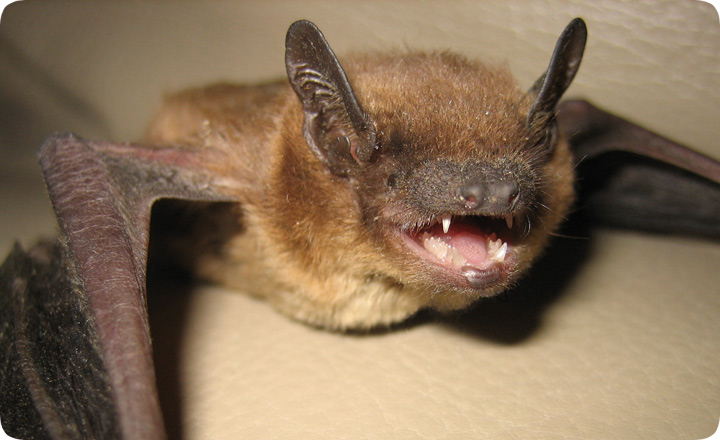-
info@aaanimalcontrol.com
Call us for help in your town
Humane Wildlife Education
Evening Bat - Nycticeius humeralis

Once again, I ought to stress two things - first of all, a bat in the house is not going to land in anyone's hair, or fly onto anyone's neck to suck blood, or anything crazy like that. The bat will merely fly around, confused. However, I also want to stress that no one should attempt to pick up a bat on the ground - this is the manner in which nearly all cases of rabies transmission occur in North America. I'm not sure if the Evening Bat is a common rabies vector. By the looks of the animal's teeth and canines (the word "fangs" would probably not apply) in the above photo, one might assume that this creature is out for blood. But no, it's out for small moths and beatles. Fancy that! I think this bat is one of the handsomer bat species. I wouldn't call it cuddly, as some bat enthusiasts would, but it's an okay looking species. Certainly more attractive than the mugs on those Free-Tail bats. Long round-edged ears, reasonable nose, velvety fur, brown eyes, ...yes, I'd date a female Evening Bat if it came down to it.
Do it yourself: Visit my How To Get Rid of Bats page for tips and advice.
Get professional help: Visit my Nationwide Pro Directory of wildlife removal experts.
For more wildlife stories, click my Wildlife Blog or click my below banner to hire a local trapper.

These bats are found in North America. They are very small bats with a brown body and have black ears as well as wings. The fur they have is dual-colored and has two tones that are brown at the base and then it starts to get to be a lighter greyish-brown when moving down. They weigh between 8-15 grams. The other measurements of their body are mentioned below in the table.
Whole body 86-105 millimeters
Tail 32-42 millimeters
Wingspan 259-280 millimeters
Hindfoot 7.5-10 millimeters
Ear (height) 11-16 millimeters
Forearm 33-38 millimeters
The evening bat is often confused with the big brown bat but the main differentiation lies in their forearms and the difference in their lengths. The evening bat has relatively smaller forearms and ranges below 40 millimeters. The brown bat also has a keeled calcar which the evening bat does not possess.
The mating process of the evening bats starts at the end of the summer and can last up to early fall. They are polygamous and one male usually mates with 20 female bats. Once a male evening bat has mated with a female bat, they part ways. The female bat goes to live in the special colonies with the rest of the female bats; it is to be noted that no male bats are in this colony. In the same colonies, the female bats give birth to their young. Usually, twins are born but triplets are sometimes born and brought up successfully by the female bats.
When a young evening bat is born it weighs less than 2 grams. They do not open their eyes until 24-30 hours have passed. At the time of their birth, they are pink and do not have any hair on their body, however, they can squeak. The male bat leaves the colony after one and a half months but the female remains there. The male bats then go on to mate the same year after leaving the colony and they never return to the colony.
As the name suggests, these bats are nocturnal. They do not fly fast, but instead choose a steady pace. Their flying pattern differs according to the time of the day, for instance, they fly low in the latter part of the day (night) but high during the earlier part of the day (evening). They are quite social and are often found to migrate from one place to another.
These bats are carnivores and prey during their steady flight. They feed on the following:
Beetles
Flies
Moths
Leafhoppers
They usually hunt with other animals and join a group of bats flying to prey. They detect their source of food by echolocation. They consume insects in huge quantities and this has been found to have a profound effect in maintaining the population of insects as well as the vegetation. At the same time, they can fall prey to other animals such as hawks, snakes, owls, and raccoons.




















